Bestsellers
-
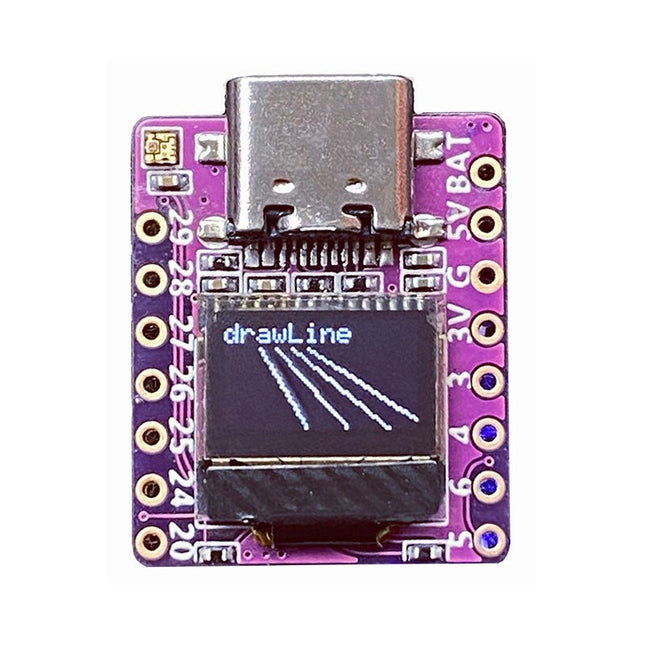
01Space 01Space RP2040-0.42LCD Development Board
Arduino, MicroPython, and CircuitPython-compatible compact development board powered by Raspberry Pi RP2040 RP2040-0.42LCD is a high-performance development board with integrated 0.42" LCD (70x40 resolution) with flexible digital interfaces. It incorporates Raspberry Pi's RP2040 microcontroller chip. The RP2040 features a dual-core Arm Cortex-M0+ processor clocked at 133 MHz with 264 KB internal SRAM and 2 MB flash storage. Specifications SoC Raspberry Pi RP2040 dual-core Cortex-M0+ microcontroller at up to 125 MHz, with 264 KB SRAM Storage 2 MB SPI flash Display 0.42-inch OLED USB 1x USB Type-C port for power and programming Expansion – Qwiic I²C connector– 7-pin and 8-pin headers with up to 11x GPIOs, 2x SPI, 2x I²C, 4x ADC, 1x UART, 5 V, 3.3 V, VBAT, GND Misc – Reset and Boot buttons– RGB LED, power LED Power supply – 5 V via USB-C port or Vin– VBAT pin for battery input– 3.3 V regulator with 500 mA peak output Dimensions 23.5 x 18 mm Weight 2.5 g Downloads GitHub
€ 19,95
Members € 17,96
-
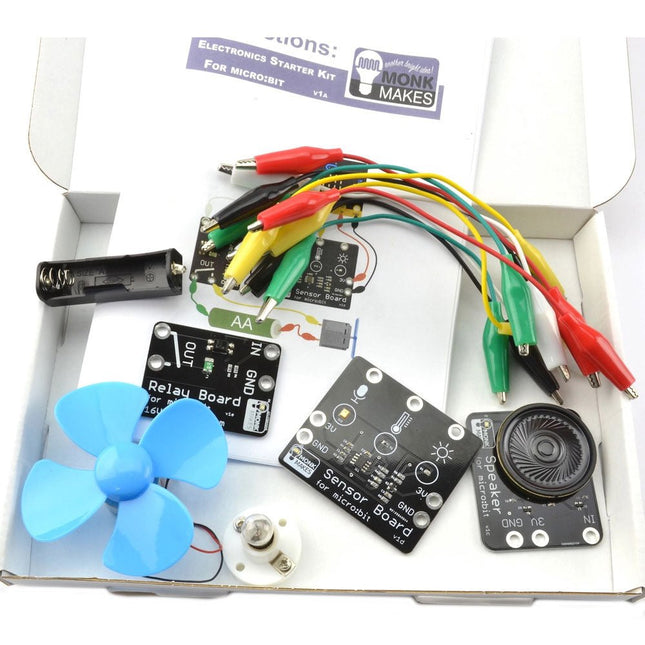
MonkMakes MonkMakes Electronic Starter Kit for micro:bit
This kit contains everything needed to start learning about connecting electronics to the micro:bit in an accessible and easy manner. Everything is connected using the supplied alligator clips, so no soldering required. Included MonkMakes Speaker for micro:bit MonkMakes Switch for micro:bit MonkMakes Sensor Board for micro:bit Set of alligator clip leads (10 leads) Small motor with fan Single AA battery box (battery not included) Light bulb and holder Booklet (A5) Downloads Instructions Datasheet Lesson Plans
€ 39,95€ 29,95
Members identical
-

FeeTech FeeTech FS90 Micro Servo with Accessories
Specifications Size 23.2 x 12.5 x 22 mm Weight 9 g Gear type Plastic Gear (Nylon & POM) Limit angle 120 Bearing No Ball bearings Horn gear spline 20T (4.8 mm) Horn type Plastic, POM Case Nylon & Fiberglass Connector wire 200 mm Motor Metal brush motor Spalsh water resistance No Included 1x FeeTech FS90 Servo 1x Straight single ended servo horn 1x Straight double ended servo horn 1x Winged straight double ended servo horn 1x Four-pointed star servo horn 1x Round servo horn 1x Servo horn screw 2x FS90 servo mounting screws Downloads User Guide
€ 12,95
Members € 11,66
-
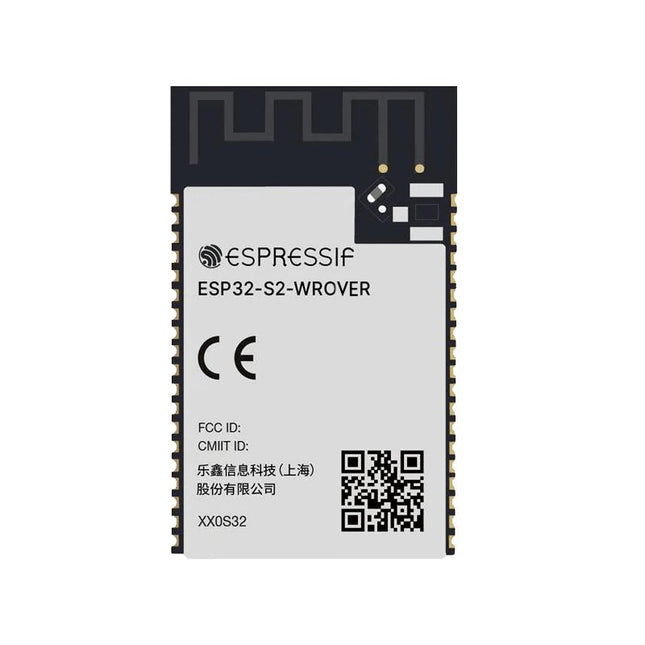
Espressif ESP32-S2-WROVER
At the core of this module is ESP32-S2, an Xtensa® 32-bit LX7 CPU that operates at up to 240 MHz. The chip has a low-power co-processor that can be used instead of the CPU to save power while performing tasks that do not require much computing power, such as monitoring of peripherals. ESP32-S2 integrates a rich set of peripherals, ranging from SPI, I²S, UART, I²C, LED PWM, TWAITM, LCD, Camera interface, ADC, DAC, touch sensor, temperature sensor, as well as up to 43 GPIOs. It also includes a full-speed USB On-The-Go (OTG) interface to enable USB communication.FeaturesMCU ESP32-S2 embedded, Xtensa® single-core 32-bit LX7 microprocessor, up to 240 MHz 128 KB ROM 320 KB SRAM 16 KB SRAM in RTC WiFi 802.11 b/g/n Bit rate: 802.11n up to 150 Mbps A-MPDU and A-MSDU aggregation 0.4 µs guard interval support Center frequency range of operating channel: 2412 ~ 2484 MHz Hardware Interfaces: GPIO, SPI, LCD, UART, I²C, I²S, Camera interface, IR, pulse counter, LED PWM, TWAI (compatible with ISO 11898-1), USB OTG 1.1, ADC, DAC, touch sensor, temperature sensor 40 MHz crystal oscillator 4 MB SPI flash Operating voltage/Power supply: 3.0 ~ 3.6 V Operating temperature range: –40 ~ 85 °C Dimensions: 18 × 31 × 3.3 mm Applications Generic Low-power IoT Sensor Hub Generic Low-power IoT Data Loggers Cameras for Video Streaming Over-the-top (OTT) Devices USB Devices Speech Recognition Image Recognition Mesh Network Home Automation Smart Home Control Panel Smart Building Industrial Automation Smart Agriculture Audio Applications Health Care Applications Wi-Fi-enabled Toys Wearable Electronics Retail & Catering Applications Smart POS Machines
€ 7,95
Members € 7,16
-

YDLIDAR YDLIDAR G4 LiDAR – 360-degree Laser Range Scanner (16 m)
After power on, YDLIDAR G4 start rotating and scanning the environment around it. The scanning distance is 16 m and the device offers a scanning rate of 9,000 times per second. It makes detailed examinations of its environment and can locate the smallest of objects surrounding it. Featuring a high-precision brushless motor and encoder disc mounted on bearings, it rotates smoothly and has a service life of up to 500,000 hours of operation. The G4 is an inexpensive solution for projects that require obstacle detection, obstacle avoidance, and/or simultaneous localization and mapping (SLAM). All YDLIDAR products are ROS ready. Features 360 degree 2D range scanning Stable performance, high precision 16 m range Strong resistance to environmental light interference Brushless motor drive, stable performance FDA Laser safety standard Class I 360 degree omnidirectional scanning, 5-12 Hz adaptive scanning frequency OptoMagnetic technology Wireless data communication Scanning rate of 9000 Hz Downloads Datasheet User Manual Development Manual SDK Tool ROS
€ 329,00€ 164,50
Members identical
-
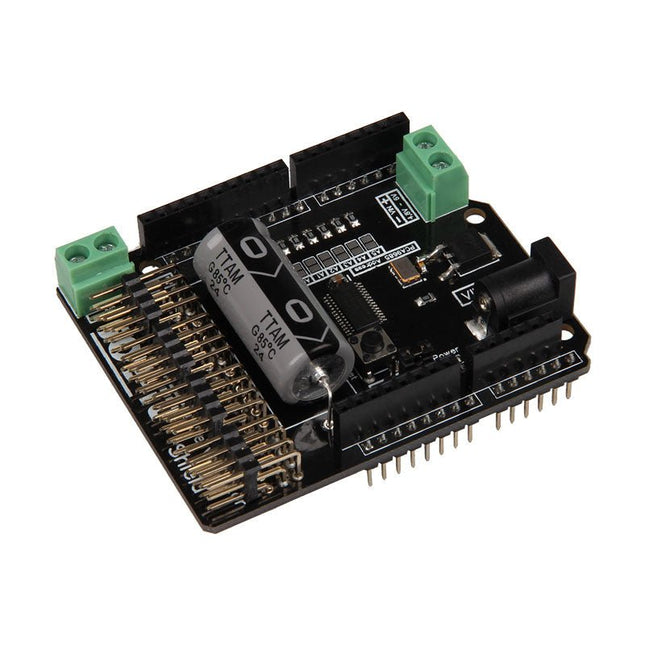
JOY-iT JOY-iT Motorino - Motor Control for Arduino
The Motorino board is an extension-board to control and use up to 16 PWM-controlled 5V-Servo-motors. The included clock generator ensures a very precise PWM signal and a very precise positioning. The board has 2 inputs for voltage from 4.8 V to 6 V which can be used for up to 11 A. With this input, a perfect power supply is always guaranteed and even bigger projects are no problem. The supply runs directly over the Motorino which provides a connection for voltage, ground and control. With the build in capacitor, the voltage is buffered which prevents a sudden voltage-drop at a high load. But there is also the possibility to connect another capacitor. The control and the programing can be done, as usual, with the Arduino. Manuals and code examples allows a quick introduction for beginners. Special features 16 Channels, own clock generator Input 1 Coaxial power connector 5.5 / 2.1 mm, 4.8-6 V / 5 A max Input 2 Screw-terminal, 4.8-6 V / 6 A max Communication 16 x PWM Compatible with Arduino Uno, Mega and may more microcontroller with Arduino compatible pinout Dimensions 69 x 24 x 56 mm Scope of supply Board, Manual, Retail package
€ 26,95
Members € 24,26
-
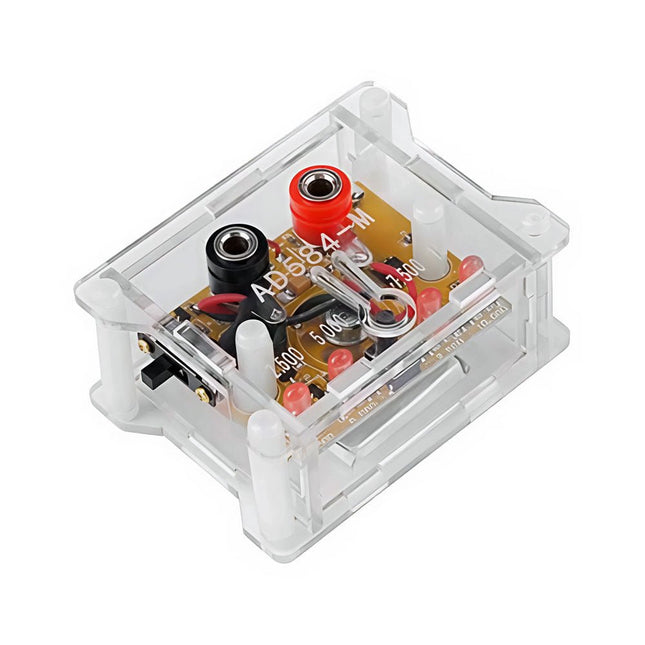
Generic AD584 4-ch Voltage Reference Module (10 V)
The AD584 4-ch Voltage Reference Module is designed to provide stable and accurate reference voltages of 2.5 V, 5 V, 7.5 V, and 10 V. It incorporates the AD584 integrated circuit, known for its high accuracy and stability. Features Multiple Output Voltages: The module can output four different reference voltages (2.5 V, 5 V, 7.5 V, and 10 V) accessible through a single port. Microcontroller-based Switching: An onboard microcontroller facilitates switching between the four voltage outputs, with LED indicators displaying the active selection. User-Friendly Operation: A single button allows for easy cycling through the available reference voltages. Transparent Housing: The module is encased in a transparent housing, offering protection while allowing users to view the internal components. Power Supply Options: It can be powered via a built-in lithium battery (not included) or through a 5 V DC input. A charging indicator provides status updates during charging. Output Interface: Equipped with 4mm banana sockets for secure and reliable connections. Included 1x AD584 4-ch Voltage Reference Module with Housing Downloads Datasheet
€ 22,95€ 11,50
Members identical
-
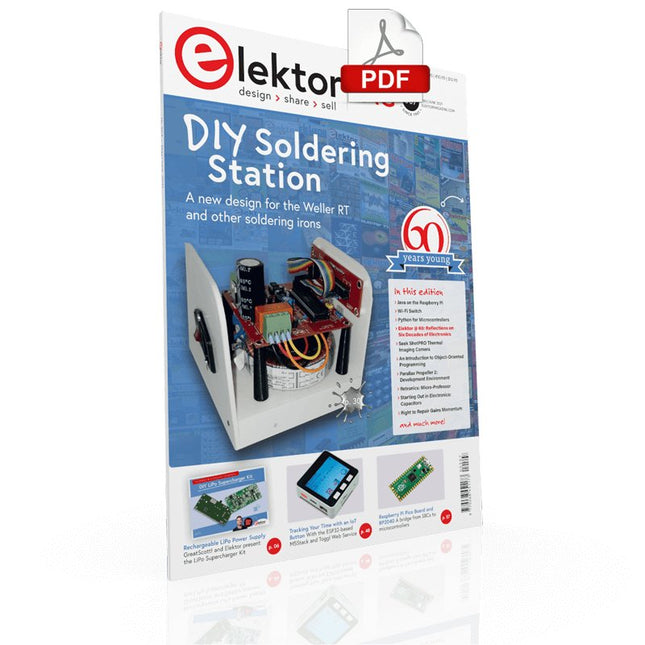
Elektor Digital Elektor May/June 2021 (PDF)
Elektor Magazine EN May/June 2021 (PDF)
€ 7,50
-
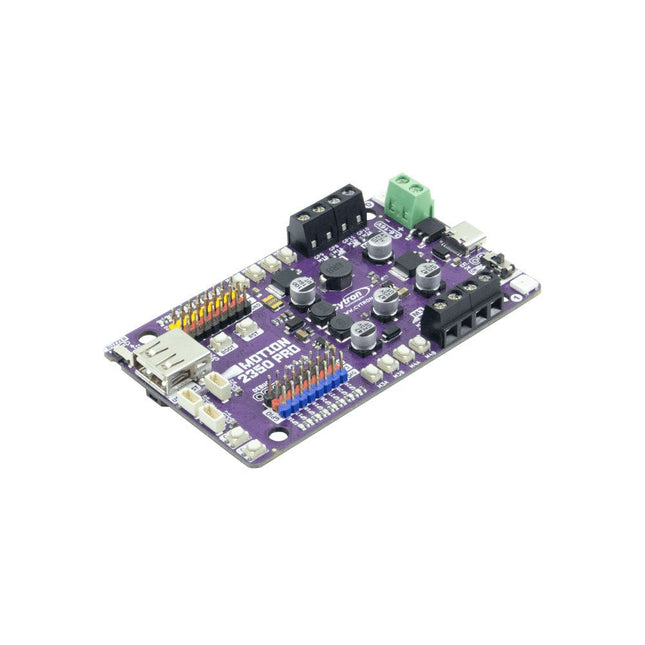
Cytron Cytron Motion 2350 Pro Robotics Controller
The Cytron Motion 2350 Pro is a robust 4-channel DC motor driver (3 A per channel, 3.6-16 V) ideal for building powerful robots, including mecanum wheel designs. It features 8-channel 5 V servo ports, 8-channel GPIO breakouts, 3 Maker Ports, and a USB host for plug-and-play joystick/gamepad support. Powered by Raspberry Pi Pico 2, it integrates seamlessly with the Pico ecosystem, supporting Python (MicroPython, CircuitPython), C/C++, and Arduino IDE. Pre-installed with CircuitPython, it comes with a demo program and quick test buttons for immediate use. Simply connect via USB-C, and start exploring! Included 1x Cytron Motion 2350 Pro Robotics Controller 1x STEMMA QT/Qwiic JST SH 4-pin Cable with Female Sockets (150 mm) 2x Grove to JST-SH Cable (200 mm) 1x Set of Silicone Bumper 4x Building Block Friction Pin 1x Mini Screwdriver
€ 29,95€ 24,95
Members identical
-

Pimoroni Pimoroni Piano HAT for Raspberry Pi
Unlock your inner Mozart with Piano HAT, a mini musical companion for your Raspberry Pi! Piano HAT is inspired by Zachary Igielman's PiPiano and made with his blessing. It has taken his fabulous idea for a dinky piano add-on for the Raspberry Pi, made it touch-sensitive and added barrels of our trademark Pimoroni polish. Play music in Python, control software synths on your Pi, and take control of hardware synthesizers! Features 16 capacitive touch pads (link each to their own Python function!) 13 piano keys (a full octave) Octave up/down buttons Instrument cycle button (great for use with synthesizers) 16 bright white LEDs (let them light automagically, or take control with Python) 2x Microchip CAP1188 capacitive touch driver chips Use it to control software or hardware synths over MIDI Compatible with all 40-pin header Raspberry Pi models Comes fully assembled Downloads Python library Pinout
€ 29,95
Members € 26,96
-

SparkFun SparkFun Thing Plus Matter (MGM240P)
The SparkFun Thing Plus Matter is the first easily accessible board of its kind that combines Matter and SparkFun’s Qwiic ecosystem for agile development and prototyping of Matter-based IoT devices. The MGM240P wireless module from Silicon Labs provides secure connectivity for both 802.15.4 with Mesh communication (Thread) and Bluetooth Low Energy 5.3 protocols. The module comes ready for integration into Silicon Labs' Matter IoT protocol for home automation. What is Matter? Simply put, Matter allows for consistent operation between smart home devices and IoT platforms without an Internet connection, even from different providers. In doing so, Matter is able to communicate between major IoT ecosystems in order to create a single wireless protocol that is easy, reliable, and secure to use. The Thing Plus Matter (MGM240P) includes Qwiic and LiPo battery connectors, and multiple GPIO pins capable of complete multiplexing through software. The board also features the MCP73831 single-cell LiPo charger as well as the MAX17048 fuel gauge to charge and monitor a connected battery. Lastly, a µSD card slot for any external memory needs is integrated. The MGM240P wireless module is built around the EFR32MG24 Wireless SoC with a 32-bit ARM Cortext-M33 core processor running at 39 MHz with 1536 kb Flash memory and 256 kb RAM. The MGM240P works with common 802.15.4 wireless protocols (Matter, ZigBee, and OpenThread) as well as Bluetooth Low Energy 5.3. The MGM240P supports Silicon Labs' Secure Vault for Thread applications. Specifications MGM240P Wireless Module Built around the EFR32MG24 Wireless SoC 32-bit ARM-M33 Core Processor (@ 39 MHz) 1536 kB Flash Memory 256 kB RAM Supports Multiple 802.15.4 Wireless Protocols (ZigBee and OpenThread) Bluetooth Low Energy 5.3 Matter-ready Secure Vault Support Built-in Antenna Thing Plus Form-Factor (Feather-compatible): Dimensions: 5.8 x 2.3 cm (2.30 x 0.9') 2 Mounting Holes: 4-40 screw compatible 21 GPIO PTH Breakouts All pins have complete multiplexing capability through software SPI, I²C and UART interfaces mapped by default to labeled pins 13 GPIO (6 labeled as Analog, 7 labeled for GPIO) All function as either GPIO or Analog Built-in-Digital to Analog Converter (DAC) USB-C Connector 2-Pin JST LiPo Battery Connector for a LiPo Battery (not included) 4-Pin JST Qwiic Connector MC73831 Single-Cell LiPo Charger Configurable charge rate (500 mA Default, 100 mA Alternate) MAX17048 Single-Cell LiPo Fuel Gauge µSD Card Slot Low Power Consumption (15 µA when MGM240P is in Low Power Mode) LEDs: PWR – Red Power LED CHG – Yellow battery charging status LED STAT – Blue status LED Reset Button: Physical push-button Reset signal can be tied to A0 to enable use as a peripheral device Downloads Schematic Eagle Files Board Dimensions Hookup Guide Datasheet (MGM240P) Fritzing Part Thing+ Comparison Guide Qwiic Info Page GitHub Hardware Repo
€ 34,95€ 17,50
Members identical
-
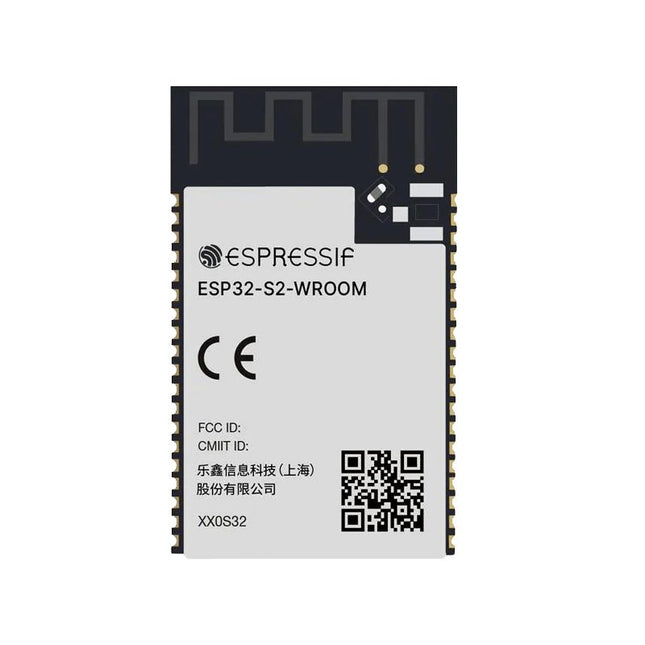
Espressif ESP32-S2-WROOM
At the core of this module is ESP32-S2, an Xtensa® 32-bit LX7 CPU that operates at up to 240 MHz. The chip has a low-power co-processor that can be used instead of the CPU to save power while performing tasks that do not require much computing power, such as monitoring of peripherals. ESP32-S2 integrates a rich set of peripherals, ranging from SPI, I²S, UART, I²C, LED PWM, TWAITM, LCD, Camera interface, ADC, DAC, touch sensor, temperature sensor, as well as up to 43 GPIOs. It also includes a full-speed USB On-The-Go (OTG) interface to enable USB communication.FeaturesMCU ESP32-S2 embedded, Xtensa® single-core 32-bit LX7 microprocessor, up to 240 MHz 128 KB ROM 320 KB SRAM 16 KB SRAM in RTC WiFi 802.11 b/g/n Bit rate: 802.11n up to 150 Mbps A-MPDU and A-MSDU aggregation 0.4 µs guard interval support Center frequency range of operating channel: 2412 ~ 2484 MHz Hardware Interfaces: GPIO, SPI, LCD, UART, I²C, I²S, Camera interface, IR, pulse counter, LED PWM, TWAI (compatible with ISO 11898-1), USB OTG 1.1, ADC, DAC, touch sensor, temperature sensor 40 MHz crystal oscillator 4 MB SPI flash Operating voltage/Power supply: 3.0 ~ 3.6 V Operating temperature range: –40 ~ 85 °C Dimensions: 18 × 31 × 3.3 mm Applications Generic Low-power IoT Sensor Hub Generic Low-power IoT Data Loggers Cameras for Video Streaming Over-the-top (OTT) Devices USB Devices Speech Recognition Image Recognition Mesh Network Home Automation Smart Home Control Panel Smart Building Industrial Automation Smart Agriculture Audio Applications Health Care Applications Wi-Fi-enabled Toys Wearable Electronics Retail & Catering Applications Smart POS Machines
€ 6,95
Members € 6,26
-
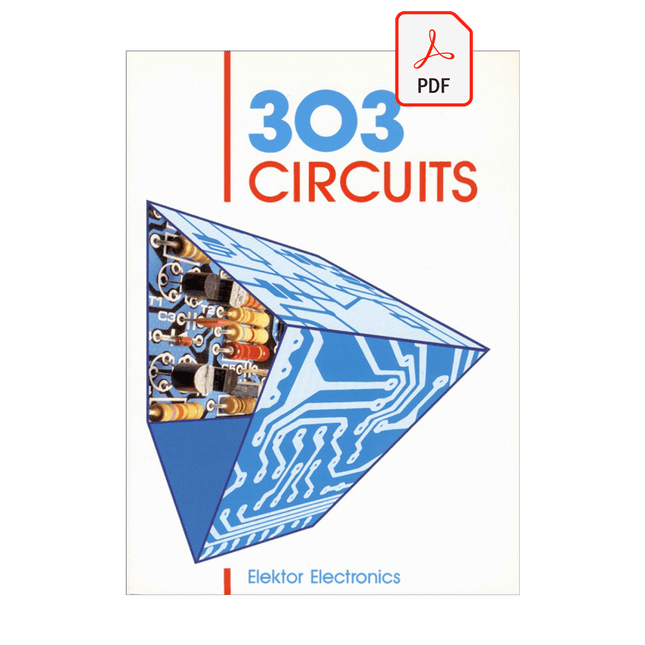
Elektor Digital 303 Circuits (E-book)
Like its predecessors in the 300 series of electronics projects books, 303 Circuits is aimed at the active electronics enthusiast, professional or amateur. Since the series was started in the early 1980s, many thousands of readers have found in these books that new approach, new concept, or new circuit they were looking for. In 303 Circuits you will find new ideas, new concepts and new circuits covering the gamut of electronics. The book is arranged in subject sections to make it easier for you to find the circuit or idea you are looking for.
€ 29,95
Members € 23,96
-

Elektor Digital Artificial Intelligence (E-book)
23 projects to bring your microcontroller to life! This book contains 23 special and exciting artificial intelligence machine-learning projects, for microcontroller and PC. Learn how to set up a neural network in a microcontroller, and how to make the network self-learning. Discover how you can breed robots, and how changing a fitness function results in a totally different behavior. Find out how a PC program exposes your weak spots in a game, and ruthlessly exploits them. Build a free-will robot, or have one clean your floor! Example projects from the book: A microcontroller that learns what your favourite color is. A robot wandering about the house looking for someone to play with. A bred robot program that is incapable of crossing a black line. A microcontroller that learns how to play a game until You just can't win anymore. A PC that programs a microcontroller all by itself. Complete with free software that you can download containing: All source code for the microcontroller. All sources of compiled PC programs (MS Windows). JAL programming language, with special editor and extension libraries. Robot breed program. Plus a support webpage with links, errata and FAQ. Several artificial intelligence techniques are discussed and used in projects such as expert system, neural network, subsumption, emerging behavior, genetic algorithm, cellular automata and roulette brains. Every project has clear instructions and pictures so you can start immediately. Suggestions and literature links allow you to go way beyond the scope of the book. Even after you have built all the projects contained within, this book will remain a valuable reference guide to keep next to your PC. A unique book for anyone with an interest in artificial intelligence and machine learning.
€ 29,95
Members € 23,96
-

Waveshare Waveshare PCIe to Gigabit Ethernet & USB 3.2 HAT for Raspberry Pi 5
The Waveshare PCIe to Gigabit Ethernet and USB 3.2 Gen 1 HAT+ is an expansion board designed specifically for the Raspberry Pi 5. It enhances the Raspberry Pi's connectivity by adding three high-speed USB 3.2 Gen 1 ports and a Gigabit Ethernet port, all in a driver-free, plug-and-play setup. Features Based on 16-pin PCIe Interface of Raspberry Pi 5 Equipped with RTL8153B high-performance Gigabit Ethernet chip Supports Raspberry Pi OS, Ubuntu, OpenWRT, etc. Stable and reliable network speed Real-time monitoring of power status Supports USB port power control via software Included 1x PCIe to Gigabit Ethernet USB 3.2 HAT+ 1x Network cable (1.5 m) 1x 16P Cable (40 mm) 1x Standoff pack Downloads Wiki
€ 32,95€ 22,95
Members identical
-
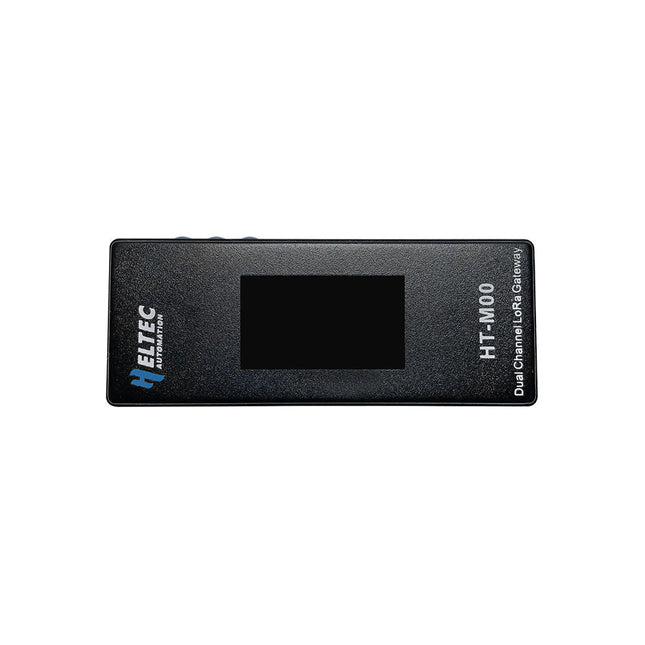
Heltec Automation Heltec HT-M00 Dual-Channel LoRa Gateway (EU868)
The HT-M00 is a dual-channel gateway that is specifically designed to cater to smart family LoRa applications that work with less than 30 LoRa nodes. The gateway has been built around two SX1276 chips that are driven by ESP32. To enable monitoring of 125 KHz SF7~SF12 spreading factor, a software mixer has been developed, which is commonly referred to as a baseband simulation program. The software mixer is a critical component that enables the HT-M00 gateway to operate with high efficiency. It is designed to simulate baseband signals, which are then mixed with the radio frequency signals to produce the desired output. The software mixer has been developed with great care and precision, and has undergone rigorous testing to ensure that it is capable of delivering accurate and reliable results. Features ESP32 + SX1276 Emulates LoRa demodulators Automatic adaptive spread spectrum factor, SF7 to SF12 for each channel is optional Maximum output: 18 ±1dBm Support for LoRaWAN Class A, Class C protocol Specifications MCU ESP32-D0WDQ6 LoRa Chipset SX1276 LoRa Band 863~870 MHz Power Supply Voltage 5 V Receiving Sensitivity -110 dBm @ 300 bps Interface USB-C Max. TX Power 17dB ±1dB Operating Temperature −20~70°C Dimensions 30 x 76 x 14 mm Included 1x HT-M00 Dual Channel LoRa Gateway 1x Wall bracket 1x USB-C cable Downloads Manual Software Documentation
€ 74,95€ 37,50
Members identical
-

Seeed Studio Seeed Studio Grove 3-Axis Digital Accelerometer (LIS3DHTR)
Grove 3-Axis Digital Accelerometer (LIS3DHTR) is a low-cost 3-Axis accelerometer in a bundle of Grove products. It is based on the LIS3DHTR chip which provides multiple ranges and interfaces selection. You can never believe that such a tiny 3-Axis accelerometer can support I²C, SPI, and ADC GPIO interfaces, which means you can choose any way to connect with your development board. Besides, this accelerometer can also monitor the surrounding temperature to tune the error caused by it. Features Measurement range: ±2g, ±4g, ±8g, ±16g, multiple ranges selection. Multiple interfaces option: Grove I²C interface, SPI interface, ADC interface. Temperature adjustable: able to adjust and tune the error caused by temperature. 3/5V power supply Specifications Power Supply 3/5V Interfaces IC/SPI/GPIO ADC I²C address Default 0x19, can be changed to 0x18 when connecting SDO Pin with GND ADC GPIO Power input 0-3.3V Interruption An interruption Pin reserved SPI Mode set up Connect the CS Pin with GND Included 1x Grove 3-Axis Digital Accelerometer (LIS3DHTR) 1x Grove cable Downloads LIS3DHTR Datasheet Hardware schematic Arduino Library
€ 7,95
Members € 7,16
-
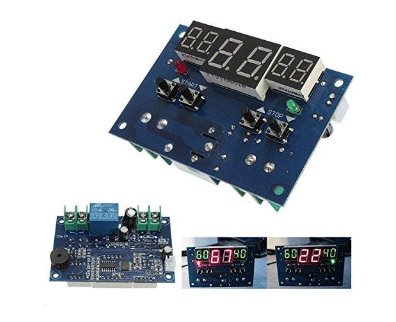
Kuongshun Intelligent Digital Temperatur Controller (W1401)
The Intelligent Digital Thermostat Temperature Controller is a small switch controller (77x51mm) which allows you to create your own thermostat. With its NTC Sensor and its LED displays, you are able to switch up to 10A 220V depending on the measured temperature.
€ 12,95
Members € 11,66
-

Voltera Voltera V-One Desktop PCB Printer
Solder Paste Dispensing and Reflow All-in-One The Voltera V-One creates two-layer prototype circuit boards on your desk. Gerber files go in, printed circuit boards come out. The dispenser lays down a silver-based conductive ink to print your circuit right before your eyes. Assembling traditional and additive boards is easy with the V-One’s solder paste dispensing and reflow features. Simply mount your board on the print bed and import your Gerber file into Voltera’s software. No more stencils required Voltera’s software is designed to be understood easily. From importing your Gerber files to the moment you press print, the software safely walks you through each step. Compatible with EAGLE, Altium, KiCad, Mentor Graphics, Cadence, DipTrace, Upverter. Included V-One PCB printer V-One dispenser V-One probe Nozzle pack Tip caps 3 x 4" FR1 substrate pack 2 x 3" FR1 substrate pack Substrate clamps Thumbscrew pack Hello World kit Solder wire Tweezers Power supply Power adapter Cables User guides Downloads Specifications V-One Software Manuals Safety Datasheets Technical Datasheets Voltera CAM file for EAGLE Substrates and Templates More Info Frequently Asked Questions More from the Voltera community Technical Specifications Printing Specifications Minimum trace width 0.2 mm Minimum passive size 1005 Minimum pin-to-pin pitch (conductive ink) 0.8 mml Minimum pin-to-pin pitch (solder paste) 0.5 mml Resistivity 12 mΩ/sq @ 70 um height Substrate material FR4 Maximum board thickness 3 mm Soldering Specifications Solder paste alloy Sn42/Bi57.6/Ag0.4 Solder wire alloy SnBiAg1 Soldering iron temperature 180-210°C Print Bed Print area 135 x 113.5 mm Max. heated bed temperature 240°C Heated bed ramp rate ~2°C/s Footprint Dimensions 390 x 257 x 207 mm (L x W x H) Weight 7 kg Computing Requirements Compatible operating systems Windows 7 or higher, MacOS 10.11 or higher Compatible file format Gerber Connection type Wired USB Certification EN 61326-1:2013 EMC requirements IEC 61010-1 Safety requirements CE Marking Affixed to the Voltera V-One printers delivered to European customers Designed and assembled in Canada. More technical information Quickstart Explore Flexible Printed Electronics on the V-One Voltera V-One Capabilities Reel Voltera V-One PCB Printer Walkthrough Unpacking the V-One V-One: Solder Paste Dispensing and Reflow All-in-One Voltera @ Stanford University's Bao Research Group: Robotic Skin and Stretchable Sensors Voltera @ Princeton: The Future of Aerospace Innovation
€ 5.499,00€ 4.949,00
Members identical
-

Raspberry Pi Foundation Raspberry Pi PoE+ Injector
The Raspberry Pi PoE+ Injector adds Power-over-Ethernet (PoE) functionality to a single port of a non-PoE Ethernet switch, delivering both power and data through one Ethernet cable. It provides a plug-and-play, cost-effective solution for incrementally introducing PoE capability into existing Ethernet networks. The PoE+ Injector is a single-port, 30 W device suitable for powering equipment compliant with IEEE 802.3af and 802.3at standards, including all generations of Raspberry Pi PoE HATs. It supports network pass-through speeds of 10/100/1000 Mbps. Note: A separate IEC mains cable is required for operation (not included). Specifications Data rate 10/100/1000 Mbps Input voltage 100 to 240 V AC Output power 30 W Power output on pins 4/5 (+), 7/8 (–) Nominal output voltage 55 V DC Data connectors Shielded RJ-45, EIA 568A and 568B Power connector IEC c13 mains power input (not included) Storage humidity Maximum 95%, non-condensing Operating altitude –300 m to 3000 m Operating ambient temperature 10°C to +50°C Dimensions 159 x 51.8 x 33.5 mm Downloads Datasheet
€ 29,95€ 14,95
Members identical
-

Elektor March/April 2025 (EN)
Elektor GREEN and GOLD members can download their digital edition here. Not a member yet? Click here. The RISC-V Open-Source Processor Architecture16 Boards and MCUs You Should Know An FPGA-Based Audio Player with Equalizer (1)Mixing Digital Audio with an Arduino MKR Vidor 4000 Laser Head for Pico-Based Sand ClockDrawing with Light Enter the STM32 Edge AI Contest A Multi-Sensor Environmental Monitoring System for PlantsWireless Measurement of Water Supply and Light Conditions Maixduino AI-Powered Automatic DoormanFace Detection with a Camera Embedded Electronics 2024AI Is Set to Redefine the Industry Charge-Based In-Memory Compute at EnCharge AI AI Inferencing at 10 Times Lower Power and 20 Fold Lower Cost Click Board Helps Develop and Train ML Models for Vibration Analysis The Elektor Mini-WheelieA Self-Balancing Robot Kit MCU, I See YouMCUViewer Open-Source Multiplatform Debugging Tool USB 2.0 IsolatorElectrically Isolated Connections for USB Devices Intervention Before DamagePredictive Maintenance in Practice SPoE – Electromagnetic CompatibilitySingle-Pair with Power-Over-Ethernet Through the Eyes of EMC Color TV: A Wonder of Its TimeCreating a New World ECG Graph MonitoringAn Implementation with Hexabitz Modules and an STM32CubeMonitor The Battle for AI at the Edge HaLow Hits Record 16-km Wi-Fi Distance at 900 MHz First CHERI RISC-V Embedded Chip and Early Access Programme Third-Generation Wildfire Detection Uses Satellite Links From Life’s ExperienceChoice Overload Starting Out in Electronics……Continues Filtering and Controls Tone Quasi-Analog ClockworkA Remake of an Elektor Classic A Modular Approach to Sensor TestingThe ESP32-S3-Based Sensor Evaluation Board 2025: An AI OdysseyThe Rise of Foundation Models and Their Role in Democratizing AI Raspberry Pi Standalone MIDI Synthesizer (1)Preparing a Platform for Some Edge AI Experiments Err-lectronicsCorrections, Updates, and Readers’ Letters Universal AI RISC-V Processor Does It All — CPU, GPU, DSP, FPGA CEO Interview: Ventiva’s Thin and Cool Tech Dual-Core Programming with a Raspberry Pi PicoVenture Into the World of Parallel Programming
€ 10,95
-

Pimoroni Pimoroni Inventor 2040 W (incl. Pico W)
Inventor 2040 W is a multi-talented board that does (almost) everything you might want a robot, prop or other mechanical thing to do. Drive a couple of fancy motors with encoders attached? Yep! Add up to six servos? Sure? Attach a little speaker so you can make noise? No problem! It's also got a battery connector so you can power your inventions from AA/AAA or LiPo batteries and carry your miniature automaton/animated top hat/treasure chest that growls at your enemies around with you untethered. You also get a ton of options for hooking up sensors and other gubbins – there's two Qw/ST connectors (and an unpopulated Breakout Garden slot) for attaching breakouts, three ADC pins for analog sensors, photoresistors and such, and three spare digital GPIO you could use for LEDs, buttons or digital sensors. Speaking of LEDs, the board features 12 addressable LEDs (AKA Neopixels) – one for each servo and GPIO/ADC channel. Features Raspberry Pi Pico W Aboard Dual Arm Cortex M0+ running at up to 133 Mhz with 264 kB of SRAM 2 MB of QSPI flash supporting XiP Powered and programmable by USB micro-B 2.4 GHz wireless 2 JST-SH connectors (6 pin) for attaching motors Dual H-Bridge motor driver (DRV8833) Per motor current limiting (425 mA) Per motor direction indicator LEDs 2 pin (Picoblade-compatible) connector for attaching speaker JST-PH (2 pin) connector for attaching battery (input voltage 2.5-5.5 V) 6 sets of header pins for connecting 3 pin hobby servos 6 sets of header pins for GPIO (3 of which are ADC capable) 12x addressable RGB LEDs/Neopixels User button Reset button 2x Qw/ST connectors for attaching breakouts Unpopulated headers for adding a Breakout Garden slot Fully assembled No soldering required (unless you want to add the Breakout Garden slot). C/C++ and MicroPython libraries Schematic Downloads Download pirate-brand MicroPython Getting Started with Raspberry Pi Pico Motor function reference Servo function reference MicroPython examples C++ examples
€ 44,95€ 22,50
Members identical
-

SB Components RoundyFi – Round LCD Board (based on ESP-12E)
Specifications Operating Voltage: 3.3 V ESP-12E MCU Display Size: 1.28 inch USB Port for Power & Data Transmission Interface Pins: 4 GPIO, 1 GND, 1 Power Driver: GC9A01 Resolution240 x 240 Pixel Color: 65 K RGB Interface: SPI Downloads STEP File Dimensions 3D File Schematic GitHub
€ 54,95€ 27,50
Members identical
-

Seeed Studio Seeed Studio Grove SI1145 Sunlight Sensor
Want to make a UV detector to know the UV index when you are under the sun? Grove Sunlight Sensor is a multi-channel digital light sensor, which has the ability to detect UV-light, visible light and infrared light. This device is based on SI1151, a new sensor from SiLabs. The Si1151 is a low-power, reflectance-based, infrared proximity, UV index and ambient light sensor with I²C digital interface and programmable-event interrupt output. This device offers excellent performance under a wide dynamic range and a variety of light sources including direct sunlight. Grove Sunlight Sensor includes an on-board Grove connector, which helps you to connect it to your Arduino easily. You can use this device for making some projects which need to detect the light, such as a simple UV detector for your Raspberry Pi weather station, or a smart irrigation system using Arduino if you need to monitor the visible spectrum. Features Multi-channel digital light sensor: can detect UV-light, visible light and infrared light Wide spectrum detection range: 280-950 nm Easy to use: I²C Interface (7-bit), compatible with Grove port, just plug-and-play Programmable configuration: Versatile for various applications 3.3/5 V Supply, suitable for many microcontrollers and SBCs Applications Light detection Smart irrigation system DIY weather station Included 1x Grove Sunlight Sensor 1x Grove Cable Downloads Schematic in PDF Schematic in Eagle File Si1145 Datasheet GitHub Repositoriy for Grove Sunlight Sensor Spectrum Lumen (unit) Ultraviolet index
€ 15,95
Members € 14,36























